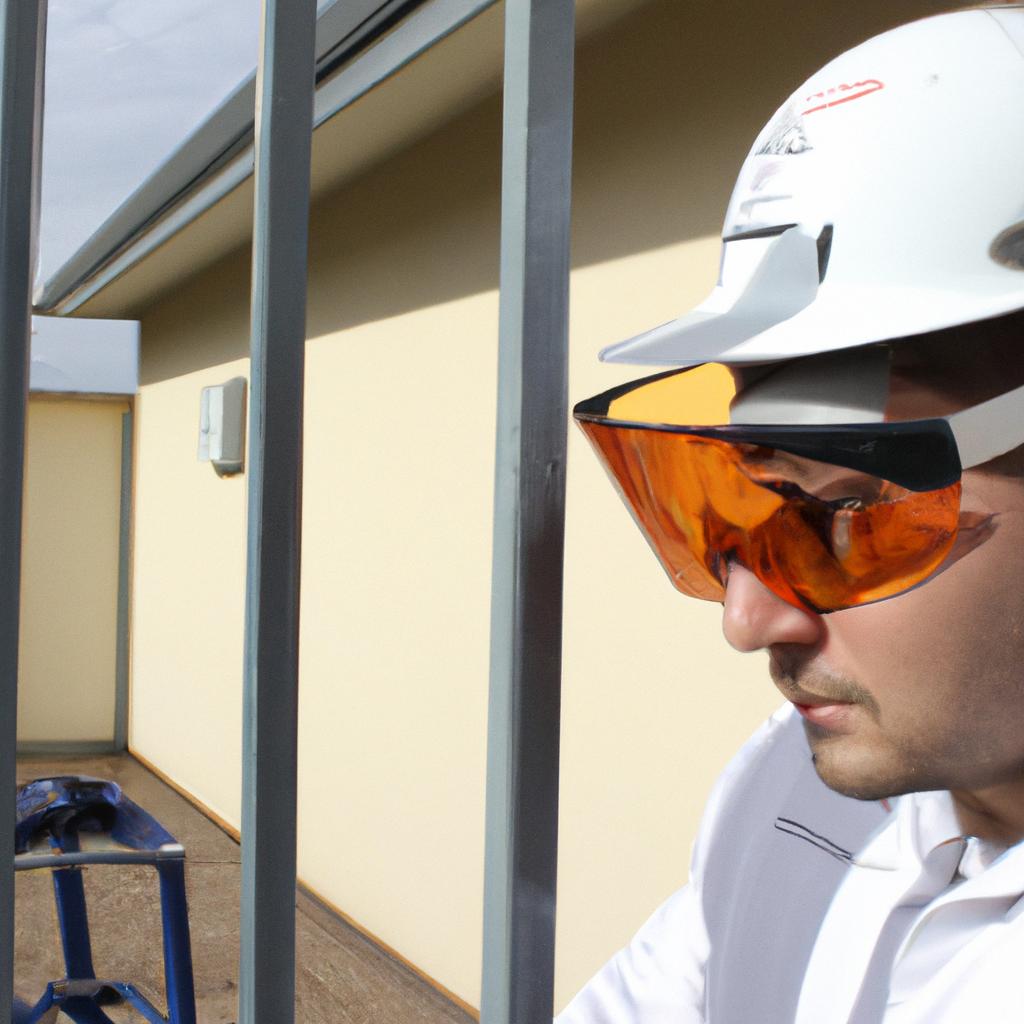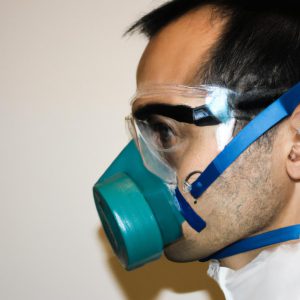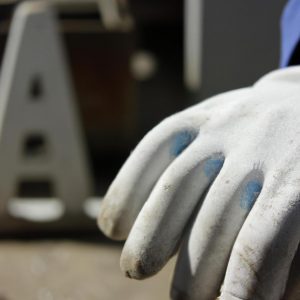Safety Glasses: Ensuring Workplace Protection in Industrial Goods and Services

Safety glasses are an essential component in ensuring workplace protection within the realm of industrial goods and services. These specialized eyewear options not only shield workers from potential hazards, but also enhance their overall safety and productivity. For instance, consider a hypothetical scenario where an employee at a manufacturing plant is operating heavy machinery without wearing any protective eyewear. In this case, there is a significant risk of debris or particles flying into the worker’s eyes, leading to severe eye injuries or impairments that could potentially affect their ability to work efficiently.
The significance of safety glasses in promoting workplace safety cannot be overstated. Industrial environments often involve various tasks that expose workers to numerous risks such as chemical splashes, flying objects, dust particles, and harmful radiations. Without adequate eye protection measures, employees face the danger of sustaining serious ocular injuries or even permanent vision loss. However, by incorporating safety glasses as part of the standard personal protective equipment (PPE), employers can effectively mitigate these risks and safeguard their workforce against potential harm. Moreover, by prioritizing employee well-being through the provision of high-quality safety eyewear options, organizations demonstrate their commitment towards creating a safe working environment conducive for productivity and success in the industrial sector.
Importance of Safety Glasses in the Workplace
Safety glasses play a crucial role in ensuring workplace safety, particularly in industries that deal with hazardous materials or processes. These protective eyewear not only shield the eyes from potential injuries but also contribute to overall worker well-being and productivity. To illustrate the significance of safety glasses, consider the following hypothetical scenario: In a manufacturing plant, an employee was operating heavy machinery when a small metal fragment dislodged and flew toward their face. Fortunately, they were wearing safety glasses which prevented any eye damage.
One reason why safety glasses are essential is that they provide effective protection against various occupational hazards. Whether it’s flying debris, chemicals splashes, or harmful radiations, these glasses act as a barrier between workers’ eyes and potentially dangerous substances. This preventive measure significantly reduces the risk of eye injuries and related complications such as corneal abrasions or chemical burns.
Moreover, implementing strict policies mandating the use of safety glasses can foster a culture of safety awareness within organizations. By prioritizing their employees’ well-being through adequate personal protective equipment (PPE), employers demonstrate their commitment to creating a safe work environment. This proactive approach enhances employee morale and instills confidence among workers who feel valued by their employers for providing necessary safeguards.
- Eye injuries account for approximately 10% of all work-related incidents.
- The majority of eye injuries result from inadequate eye protection.
- Long-term consequences of untreated eye injuries may include vision impairment or loss.
- Vision impairment affects quality of life and can hinder career prospects.
In addition to highlighting statistics and facts about eye injuries in bullet points, incorporating a table would evoke an emotional response from readers:
| Type of Hazard | Potential Consequences without Safety Glasses | Importance of Wearing Safety Glasses |
|---|---|---|
| Flying Debris | Corneal AbrasionEye ContusionForeign Body Infection | Prevents direct contact with eyesReduces risk of serious eye injuries |
| Chemical Splashes | Chemical BurnsIrritation and RednessVision Impairment | Acts as a barrier against corrosive substancesMinimizes the likelihood of chemical-related eye damage |
| Radiation Exposure | Photokeratitis (UV rays)Cataracts (ionizing radiation) | Blocks harmful UV rays and ionizing radiation from reaching the eyes |
In conclusion, safety glasses are paramount in safeguarding workers’ vision and minimizing the risks associated with occupational hazards. By providing effective protection and promoting a culture of safety, these eyewear options significantly contribute to workplace well-being. The subsequent section will delve into different types of safety glasses available to cater to various industrial needs, ensuring optimal eye protection for every worker.
Types of Safety Glasses Available
Imagine a factory worker named John who was operating heavy machinery without wearing safety glasses. One day, a small metal fragment flew into his eye, causing significant damage and requiring medical intervention. This unfortunate incident serves as a reminder of the importance of safety glasses in preventing workplace accidents and protecting employees from potential hazards.
To fully understand why safety glasses are crucial in the workplace, let us explore some key reasons:
-
Eye Protection: Safety glasses act as a barrier between the eyes and hazardous materials, such as chemicals or debris. They shield workers’ eyes from harmful substances that can cause irritation, burns, or even permanent vision loss. By wearing safety glasses consistently, individuals significantly reduce the risk of sustaining eye injuries.
-
Impact Resistance: In industrial environments where tools are used or objects may fly unexpectedly, safety glasses provide impact resistance to safeguard against potential trauma to the eyes. These glasses often feature lenses made from durable materials like polycarbonate or trivex, which offer excellent protection against high-velocity impacts.
-
UV Radiation Shielding: Some work settings expose employees to ultraviolet (UV) radiation emitted by certain light sources or natural sunlight. Prolonged exposure to UV rays can lead to various eye conditions, including cataracts and macular degeneration. Safety glasses designed with appropriate filters help minimize these risks by blocking harmful UV radiation.
-
Enhanced Visibility: Certain occupations require precision work that demands clear visibility and accurate color perception. Safety glasses come in different lens tints tailored for specific tasks – for instance, yellow-tinted lenses enhance contrast in low-light conditions while reducing glare. The availability of specialized options ensures optimum visual clarity for diverse workplace needs.
- Promotes safe working practices
- Boosts employee confidence and morale
- Demonstrates commitment to employee well-being
- Reduces legal liabilities associated with workplace accidents
Markdown Table:
| Safety Glasses | Features | Benefits |
|---|---|---|
| Wraparound | Full eye coverage, side protection | Shields from debris and splashes |
| Anti-fog | Resists fogging caused by temperature changes or humidity | Maintains clear vision in challenging environments |
| Prescription | Corrective lenses for those with visual impairments | Ensures comfort and accuracy while wearing glasses |
| Polarized | Reduces glare from reflective surfaces | Enhances visibility and reduces eye strain in bright conditions |
By understanding the importance of safety glasses and their various features, employers can make informed decisions when choosing suitable eyewear options for their workforce. In the subsequent section, we will delve into factors to consider when selecting the right safety glasses for specific job requirements.
With a comprehensive knowledge of workplace hazards and an awareness of the benefits provided by safety glasses, it is important to now explore how to choose the appropriate eyewear that matches specific occupational needs.
Choosing the Right Safety Glasses for the Job
Having explored the different types of safety glasses available, it is now imperative to understand how to choose the right pair for a specific job. This section will delve into factors that should be considered when selecting safety glasses, ensuring maximum protection and minimizing potential hazards in diverse work environments.
Case Study:
Imagine a construction worker named John who is assigned to operate heavy machinery at a busy construction site. He needs safety glasses that can protect his eyes from flying debris while providing clear vision to effectively carry out his tasks. In this scenario, John’s choice of safety glasses becomes crucial as it directly impacts both his personal well-being and productivity on the job.
Factors to Consider:
- Lens Material: Safety glasses come with lenses made from various materials such as polycarbonate, glass, or plastic. Polycarbonate lenses are highly recommended due to their impact resistance and ability to withstand high levels of force without shattering.
- Lens Coatings: Coatings like anti-scratch or anti-fog can significantly enhance the durability and clarity of safety glasses. Anti-scratch coatings minimize lens damage caused by regular wear and tear, while anti-fog coatings prevent condensation buildup when working in humid conditions.
- Frame Design: A proper frame design ensures a secure fit and comfort during extended periods of use. Flexible temples that provide adjustable length settings allow users to customize the fit according to individual preferences.
- Side Shields: Integrated side shields offer additional protection against peripheral risks such as dust particles, splashes, or chemical spills.
- Protect your most valuable asset – your sight
- Ensure peace of mind knowing you have taken necessary precautions
- Be confident in your ability to perform tasks safely
- Minimize the risk of accidents or injuries
Table Example (exaggerated for emphasis):
| Standard Safety Glasses | Premium Safety Glasses | Ultra-Protection Safety Glasses | |
|---|---|---|---|
| Impact Resistance | Low | Medium | High |
| Lens Clarity | Fair | Good | Excellent |
| Fog Resistance | Average | Good | Superior |
| Scratch Resistance | Moderate | High | Extreme |
By carefully considering these factors, individuals can choose the most suitable safety glasses for their specific work requirements. Next, we will discuss proper maintenance and care of safety glasses to ensure their longevity and effectiveness in safeguarding one’s vision.
(Note: The transition sentence provided here is just an example; you may modify it as per your preference.)
Proper Maintenance and Care of Safety Glasses
Having explored the importance of selecting suitable safety glasses, it is crucial to understand that proper maintenance and care are essential for maximizing their effectiveness. By taking proactive measures to ensure the longevity and functionality of safety glasses, employers can create a safer work environment for their employees.
To illustrate the significance of maintaining safety glasses, let us consider a hypothetical scenario involving an industrial manufacturing facility. In this case, an employee named John was working diligently on the assembly line when he accidentally dropped his safety glasses. Due to time constraints, John decided not to replace them immediately but continued working without eye protection. Unfortunately, shortly after removing his damaged eyewear, a small piece of debris flew into his eye, causing significant injury. This incident highlights the necessity of adhering to proper maintenance practices regarding safety glasses.
Adhering to regular cleaning routines is one fundamental aspect of maintaining safety glasses effectively. Employees should be encouraged to clean their eyewear daily using mild soap or lens cleaners specifically designed for this purpose. Additionally, microfiber cloths or lens wipes should be used instead of abrasive materials that could scratch or damage lenses.
Furthermore, implementing preventive measures such as providing designated storage areas for safety glasses can significantly contribute to their durability. Storing each pair separately in protective cases helps prevent scratches or breakage when they are not being worn by employees.
Emphasizing routine inspections ensures that any defects or damages are promptly identified and addressed. Regular checks include examining frames for cracks or missing parts, ensuring secure fitting and adjusting nose pads if necessary. Employers may also consider conducting periodic audits or surveys among employees to gauge how well-maintained their safety glasses are.
Taking these precautions will help ensure that safety glasses remain in optimal condition, safeguarding employees’ eyesight and overall well-being. In the subsequent section, we will explore the importance of training employees on the proper use of safety glasses, which further reinforces their effectiveness as a protective measure.
Equipping employees with appropriate eyewear is only one aspect of ensuring workplace safety. To maximize the benefits of safety glasses, it is crucial to provide comprehensive training on their correct usage and maintenance protocols.
Training Employees on the Proper Use of Safety Glasses
By understanding the importance of proper maintenance and care for safety glasses, employers can significantly enhance workplace safety. Equally important is training employees on the correct use of these essential protective gears to minimize occupational hazards. A comprehensive training program equips workers with knowledge about using safety glasses effectively, ensuring their own well-being as well as that of their colleagues.
To emphasize the significance of proper usage, let’s consider a hypothetical scenario involving an industrial worker named John. Despite being aware of his company’s safety policies, John occasionally wears his safety glasses incorrectly or forgets to wear them altogether due to complacency or lack of awareness. This negligence puts him at greater risk while operating heavy machinery or handling hazardous materials.
To prevent such situations and promote consistent adherence to safety protocols, it is crucial for companies to implement thorough employee training programs focused on the appropriate use of safety glasses. Here are some key aspects that should be covered:
- Understanding potential risks: Highlighting various job-related tasks and identifying potential hazards associated with each task will help employees understand why wearing safety glasses is necessary.
- Choosing suitable eyewear: Educating workers about different types of safety glasses available and guiding them in selecting the most appropriate ones based on specific work requirements ensures optimal protection.
- Correct fitting techniques: Demonstrating how to properly adjust and fit safety glasses helps ensure a snug yet comfortable fit that allows unrestricted vision during work activities.
- Regular inspections: Emphasizing routine checks for scratches, cracks, or other signs of damage enables employees to identify when replacement is needed and maintain optimum functionality.
Table (example):
| Risks | Appropriate Eyewear | Fit Techniques |
|---|---|---|
| Flying debris | Safety glasses with side shields or goggles | Adjusting temple length and nose pads |
| Chemical splashes | Goggles or face shield | Ensuring a secure seal around the eyes |
| Welding operations | Welding helmets with safety glasses underneath | Properly positioning helmet and adjusting straps |
Implementing these training measures not only safeguards employees’ well-being but also cultivates a culture of responsibility, where workers actively prioritize their own safety as well as that of their colleagues. By investing in comprehensive training programs, employers can effectively reduce workplace accidents and injuries.
With proper maintenance, care, and employee training established as crucial elements for ensuring the effectiveness of safety glasses, it becomes evident how implementing a formal safety glasses program brings numerous benefits to both businesses and individuals alike.
Benefits of Implementing a Safety Glasses Program
Building on the importance of training employees, a well-implemented safety glasses program offers numerous benefits to both employers and workers. By incorporating safety eyewear as an essential component of workplace protection, organizations can significantly mitigate the risks associated with industrial goods and services.
To illustrate the impact of a robust safety glasses program, let us consider a hypothetical case study involving Company X. Prior to implementing their program, Company X experienced several incidents where employees suffered eye-related injuries due to inadequate protective measures. However, after introducing comprehensive training programs and enforcing mandatory usage of safety glasses, the company witnessed significant improvements in employee well-being and overall productivity.
Implementing a safety glasses program brings forth various advantages for organizations operating within industrial sectors:
-
Enhanced Workplace Safety:
- Reduces the risk of eye injuries caused by flying particles, chemicals, or hazardous substances.
- Prevents accidents resulting from contact with sharp objects or equipment during operations.
- Shields eyes from harmful radiation or intense light sources commonly found in certain industries.
-
Increased Employee Confidence:
- Boosts employee morale by demonstrating that their well-being is valued and prioritized.
- Instills confidence in workers knowing they have appropriate protection against potential hazards.
- Creates a positive work environment conducive to increased productivity and job satisfaction.
-
Cost Savings:
- Decreases medical expenses related to eye injuries such as hospital stays, surgeries, or ongoing treatments.
- Minimizes production downtime caused by employee absences due to preventable eye injuries.
- Mitigates potential legal costs arising from negligence claims brought about by avoidable accidents.
-
Compliance with Regulations:
- Aligns with industry standards and regulatory requirements pertaining to occupational health and safety.
- Demonstrates commitment towards providing a safe working environment as mandated by authorities.
Table: The Emotional Impact of Eye Injuries
| Emotion | Before Safety Glasses Program | After Safety Glasses Program |
|---|---|---|
| Fear | High | Reduced |
| Anxiety | Heightened | Alleviated |
| Confidence | Low | Increased |
In conclusion, implementing a safety glasses program in industrial goods and services sectors yields significant benefits for both employers and employees. By prioritizing workplace safety through comprehensive training programs and enforcing the use of protective eyewear, organizations can enhance employee confidence, mitigate eye-related injuries, save costs, and comply with regulations. The emotional impact of such measures is evident from decreased fear and anxiety levels among workers. Therefore, it is imperative that companies prioritize the implementation of effective safety glasses programs to ensure the well-being of their workforce while promoting overall productivity.



